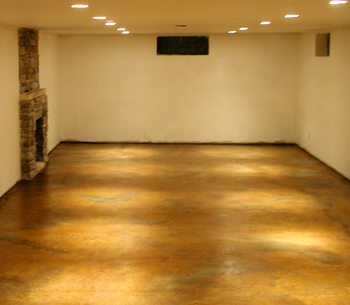 |
||||||||||
|
December 21, 2004
In This Issue of The Acid Staining Newsletter Paint Stripping with Flakey Jake
In a past newsletter called “The Paint Removal Dilemma” I wrote about chemical paint stripping versus mechanical means of removal. I thought that hiring a shot-blaster was THE mechanical way to strip layers of paint, so I went into the pros and cons of that method as compared with chemical removers. The contents of that newsletter are still valid, but I have since heard from a correspondent about yet another mechanical removal method which I did not know existed. I trust this person’s report because he is not a representative of the company which makes this machine; as he puts it he is “just a lowly weekend warrior” who wanted to revamp the look of his 675 square-foot basement in
|
||||||||||
|
I just wanted to share how I removed one layer of carpet glue and three coats of paint from my basement floor in preparation for acid stain.
The carpet glue was removed with a rotary floor sander. The glue was old stuff from the 50’s or 60’s. It was brown and dusty when removed. It was hard to get the sander started because it stuck to the glue. I received many bruises from the sander! After the glue was stripped, it was swept up and removed.
This got me down to three layers of paint. For this, I used a commercial floor grinder/polisher used for honing terrazzo. I rented an attachment for the grinder called a Flakey Jake. These are steel inserts for the grinder which hold a sharp carbide blade. The unit successfully scraped about 80% of the paint from the floor.
|
||||||||||
 |
||||||||||
 |
||||||||||
Whew! I think I might have stopped after the grinding and turned to strong citrus cleaners to soak and dissolve the remaining paint, rather than get into all the pressure-washing. I had not known that a pressure-washer could remove paint from crevices. Rick sent me a link to the kind of grinding machine he used which is: We don’t have any process photos of the cleaning procedure (that is probably something Rick doesn’t want to remember), but we have two photos of the finished floor which we are publishing here. Rick purchased Brickform Blushtone Stain from Rafco Products. He contacted them at www.altamardc.com. They were able to deliver the stain to his house, 60 miles away for $15-25. He reports that the Brickform guys were helpful about staining, but that he had some problems with the oil-based sealer which they recommended and would not use it again. Rick sprayed on half jade and half caramel colored stains, but for blue highlights he threw Miracle-Gro crystals into the stained areas, broadcasting them in arcs. He then covered the stained areas with thin painter’s plastic drop cloths, which slowed down the reaction and eased the transitions between colors (just as I describe in my book, Advanced Artistic Techniques). I told Rick that he must have been using an old batch of Miracle-Gro, since their newer formulation just makes white spots. He answered that the coloring agent in Miracle-Gro is probably a Hydrated Copper Sulfate CuSO4*5h20. This mineral is called Chalcanthite and you can read all about it at: http://www.galleries.com/minerals/sulfates/chalcant/chalcant.htm You can order some hydrated copper sulfate through chemical supply companies. Rick says to try: http://www.chemicalland21.com This is a company in
For a company in the
www.oldbridgechem.com/CuSO4.html I have not tried using Chalcanthite with stain yet, so I would like to hear from someone who has. We found that the old Miracle-Gro, thrown into blue acid stain could take it from pale turquoise to a really brilliant cobalt color. It would be a nice Christmas present to regain the ability to do this. Many thanks, Rick the Warrior, for helping me to write this newsletter. Have a wonderful and safe holiday season and Happy Staining! |
||||||||||
|
|
||||||||||
